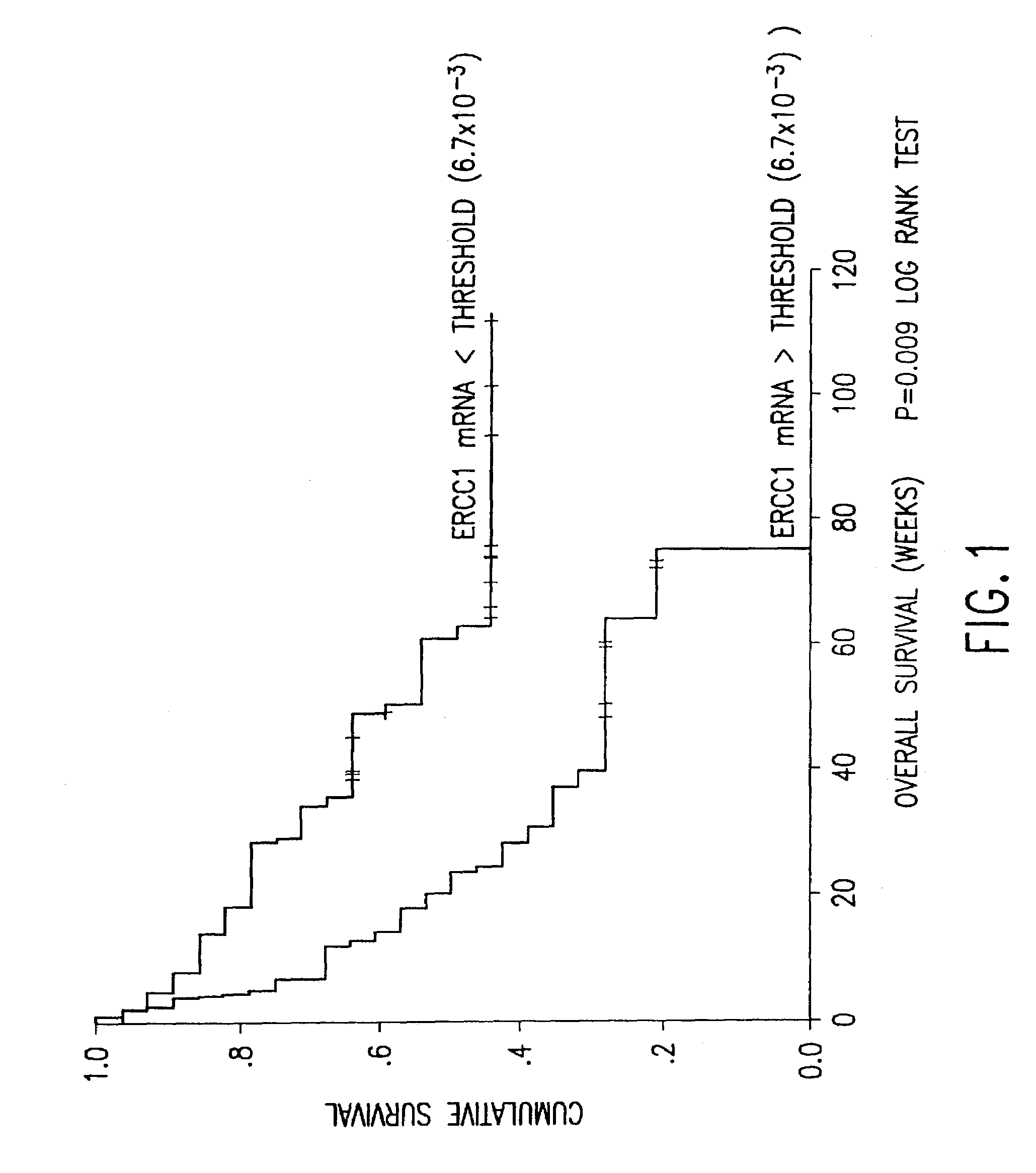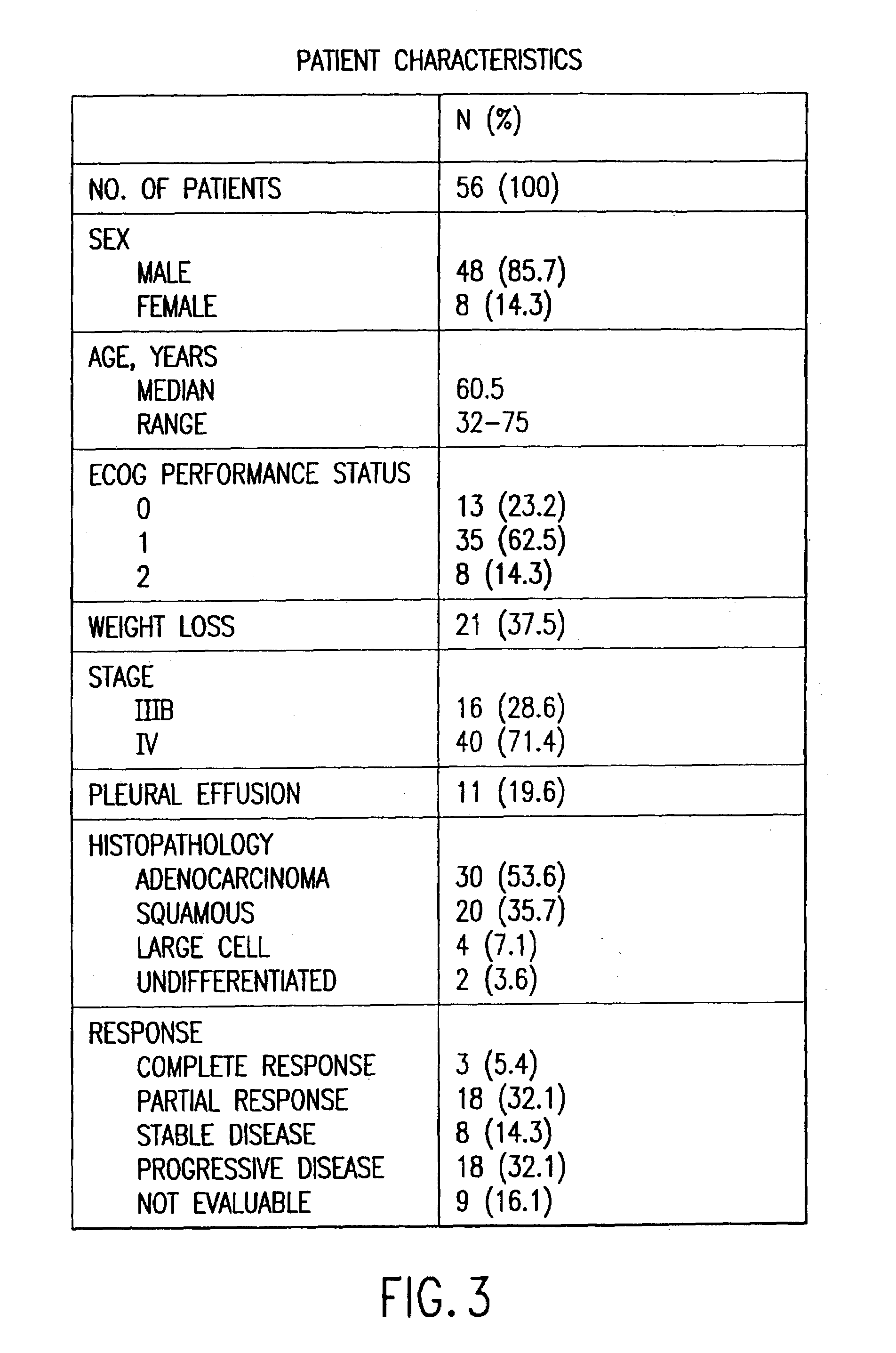Method of determining a chemotherapeutic regimen based on ERCC1 expression
a technology of ercc1 and chemotherapeutic regimen, applied in the field of prognostic methods, can solve the problems of impeded dna replication, impeded dna replication, and/or inhibited the expression of genes needed for cell survival,
- Summary
- Abstract
- Description
- Claims
- Application Information
AI Technical Summary
Benefits of technology
Problems solved by technology
Method used
Image
Examples
example 1
RNA Isolation from FPE Tissue
[0074]RNA is extracted from paraffin-embedded tissue by the following general procedure.
[0075]A. Deparaffinization and Hydration of Sections:
[0076](1) A portion of an approximately 10 μM section is placed in a 1.5 mL plastic centrifuge tube.
[0077](2) 600 μL, of xylene are added and the mixture is shaken vigorously for about 10 minutes at room temperature (roughly 20 to 25° C.).
[0078](3) The sample is centrifuged for about 7 minutes at room temperature at the maximum speed of the bench top centrifuge (about 10–20,000×g).
[0079](4) Steps 2 and 3 are repeated until the majority of paraffin has been dissolved. Two or more times are normally required depending on the amount of paraffin included in the original sample portion.
[0080](5) The xylene solution is removed by vigorously shaking with a lower alcohol, preferably with 100% ethanol (about 600 μL) for about 3 minutes.
[0081](6) The tube is centrifuged for about 7 minutes as in step (3). The supernatant is d...
example 2
[0093]mRNA Reverse Transcription and PCR
[0094]Reverse Transcription: RNA was isolated from microdissected or non-microdissected formalin fixed paraffin embedded (FPE) tissue as illustrated in Example 1 and as previously described in U.S. application Ser. No. 09 / 469,338 filed Dec. 20, 1999, which is hereby incorporated by reference in its entirety. After precipitation with ethanol and centrifugation, the RNA pellet was dissolved in 50 μl of 5 mM Tris / Cl at pH 8.0. M-MLV Reverse Transcriptase will extend an oligonucleotide primer hybridized to a single-stranded RNA or DNA template in the presence of deoxynucleotides, producing a complementary strand. The resulting RNA was reverse transcribed with random hexamers and M-MLV Reverse Transcriptase from Life Technologies. The reverse transcription was accomplished by mixing 25 μl of the RNA solution with 25.5 μl of “reverse transcription mix” (see below). The reaction was placed in a thermocycler for 8 min at 26° C. (for binding the random...
example 3
[0100]Determining the Uncorrected Gene Expression (UGE) for ERCC1
[0101]Two pairs of parallel reactions are carried out, i.e., “test” reactions and the “calibration” reactions. The ERCC1 amplification reaction and the β-actin internal control amplification reaction are the test reactions. Separate ERCC1 and β-actin amplification reactions are performed on the calibrator RNA template and are referred to as the calibration reactions. The TaqMan® instrument will yield four different cycle threshold (Ct) values: CtERCC1 and Ctβ-actin from the test reactions and CtERCC1 and Ctβ-actin from the calibration reactions. The differences in Ct values for the two reactions are determined according to the following equation:
ΔCttest=CtERCC1−Ctβ-actin (From the “test” reaction)
ΔCtcalibrator=CtERCC1−Ctβ-actin (From the “calibration” reaction)
[0102]Next the step involves raising the number 2 to the negative ΔCt, according to the following equations.
2−ΔCttest (From the “test” reaction)
2−ΔCtcalibrator (...
PUM
| Property | Measurement | Unit |
|---|---|---|
| Temperature | aaaaa | aaaaa |
| Fraction | aaaaa | aaaaa |
| Fraction | aaaaa | aaaaa |
Abstract
Description
Claims
Application Information
 Login to View More
Login to View More - R&D
- Intellectual Property
- Life Sciences
- Materials
- Tech Scout
- Unparalleled Data Quality
- Higher Quality Content
- 60% Fewer Hallucinations
Browse by: Latest US Patents, China's latest patents, Technical Efficacy Thesaurus, Application Domain, Technology Topic, Popular Technical Reports.
© 2025 PatSnap. All rights reserved.Legal|Privacy policy|Modern Slavery Act Transparency Statement|Sitemap|About US| Contact US: help@patsnap.com



